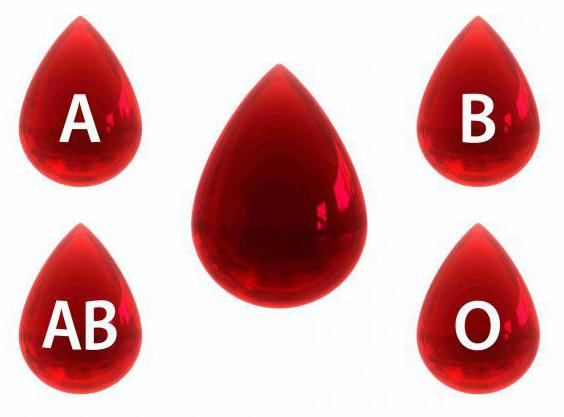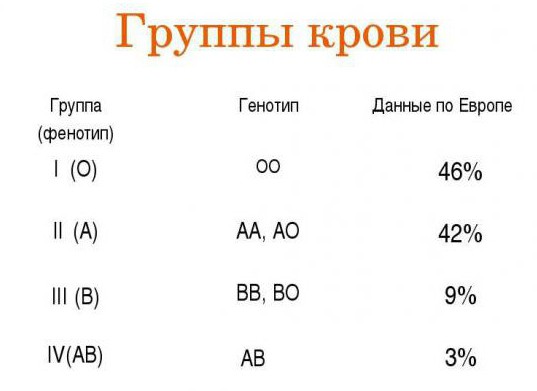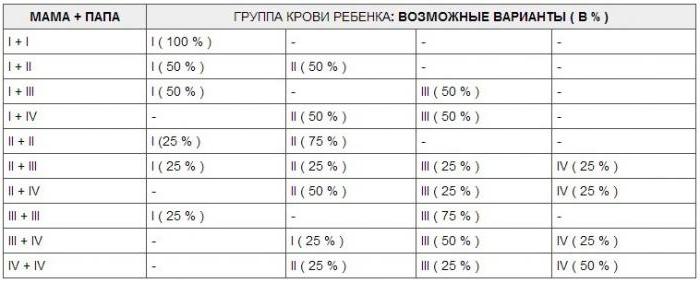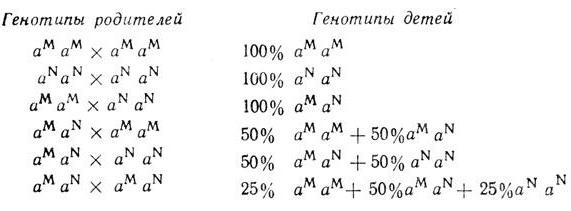How to solve the problem for the blood group and Rh factor
The solution of genetics tasks for the blood group isnot only an exciting pastime in biology lessons, but also an important process that is used in practice in various laboratories and medical-genetic consultations. There are specific features that are directly related to the inheritance of human blood group genes.
Different variants of recording a group of human blood
Blood is the liquid medium of the body, and in itthere are uniform elements - erythrocytes, as well as liquid plasma. The presence or absence of any substances in the human blood is programmed at the genetic level, which is displayed by the corresponding record when solving problems.
The most common are three types of records of the human blood group:
- By the system AB0.
- By the presence or absence of Rh factor.
- By the MN system.

The system AB0
The basis of this type of record isthe interaction of genes, like codomination. It says that a gene can be represented more than two different alleles, and each of them in the human genotype has its own manifestation.
To solve the problem, the blood group should beremember one more rule of codomination: there are no recessive or dominant genes. This means that different combinations of alleles can give a wide variety of descendants.
Gene A in this system is responsible for the appearanceantigen A on the surface of erythrocytes, gene B - for the formation of antigen B on the surface of these cells, and gene 0 for the absence of any antigen. For example, if a person's genotype is recorded as IAIB (gene I is used to solve the problem of genetics per blood group), then both antigens are present on its red blood cells. If he does not have these antigens, but there are antibodies "alpha" and "beta" in the plasma, then his genotype is recorded as I0I0.

Based on the blood group, a transfusion is performed fromdonor to the recipient. In modern medicine, we came to the conclusion that the best transfusion is the case when both the donor and the recipient have the same blood group. However, a situation may arise in practice when it is not possible to find a suitable person with the same blood group as the victim who needs a transfusion. In this case, the phenotypic features of the first and fourth group are used.
People with the first group on the surfaceerythrocytes there are no antigens, which makes it possible to transfuse such blood to any other person with the least consequences. This means that such people are universal donors. If it is a question of group 4, then such organisms belong to universal recipients, that is, they can receive blood from any donor.
Tasks for the blood group require a specific record of genotypes. Here are 4 groups of people by the presence of antigens on the surface of red blood cells and their possible genotypes:
I (0) is the group. Genotype I0I0.
II (A) -group. Genotypes IAIA or IAI0.
III (B) -group. Genotypes of IBIB or IBI0.
IV (AB) -group. The genotype IAIB.

Blood groups by Rh factor
Another way to designate human blood groups,which is based on the presence or absence of Rh factor. This factor is also a complex protein, which is formed in the blood. It is encoded by several pairs of genes, but the determining role is assigned to the genes, which are denoted by the letters D (positive Rh, or Rh +) and d (negative Rh, or Rh-). Accordingly, the transfer of this feature is due to monogenic inheritance, rather than to codomination.
Tasks for blood groups with a solution require the following genotype record:
- People with Rh-positive blood type have genotypes DD or Dd.
- In people with a negative Rh factor, the genotype is recorded as dd.

MN system
This method of recording is more common in countriesWestern Europe, but it can also be used to solve the problem of the blood group. It is based on the manifestation of two allelic genes, which are inherited by the type of codomination. Each of these alleles is responsible for protein synthesis in the human blood. If the genotype of the organism is a combination of MM, then only the type of protein that is encoded by the corresponding gene is present in its blood. If such a genotype is exchanged for MN, then there will be two different kinds of protein in the plasma.
The tasks for the MN blood group require the following genotype record:
- A group of people with the MN genotype.
- A group of people with the genotype MM.
- A group of people with the genotype NN.

Features of solving problems in genetics
When registering genetic problems, the following rules should be observed:
- Write a table of the test signs, as well as genes and genotypes, which are responsible for the manifestation of this trait.
- Write the parents' genotypes: first a female is written, then a male one.
- Identify the gametes that each individual gives.
- To trace the genotypes and phenotypes of descendants in F1, and if it requires that task, write the probability of their occurrence.
Also the solution of problems on genetics on blood groupsrequires an understanding of the type of interaction that you were offered in the condition. This determines the course of the decision, and also you can predict in advance the results of crossing and the possible likelihood of the appearance of zygotes. If two or more types of gene interaction are suitable for the same condition, the simplest of them is always taken.

Problems in the system AVO
The tasks of biology for the blood group according to the ABO system are solved as follows:
"A woman who has the first blood group, married a man with a fourth blood group. Identify the genotype and phenotype of their children, as well as the probability of the appearance of zygotes with different genotypes. "
First, we need to know which genes are responsible for which manifestation of traits:
| Symptom | Genes | Genotype |
| 1 blood type | I0 | I0I0 |
| 2 blood type | IA, I0 | IAIA, IAI0 |
| 3 blood type | IB, I0 | IBIB, IBI0 |
| 4 blood type | IA, IB | IAIB |
Then, we write the genotypes of parents and their gametes:
- P: ♀ I0I0 × ♂ IAIB.
- G: I0 I0 IA IB.
Further, we alternately cross the obtained gametes with each other. To do this, you can use the Penet lattice:
| gametes for women / men | IA | IB |
| I0 | IAI0; 2 blood type | IBI0; 3 blood type |
| I0 | IAI0; 2 blood type | IBI0; 3 blood type |
Since the probability of formation of gametes of both parents is 50%, then each of the 4 variants of the child's genotypes can appear with a 25% probability.
Solving problems: blood group, Rh factor
When solving problems with the Rh factor, we canuse the rules of ordinary monogenic inheritance of characteristics. For example, we are a man and a woman married and both were Rh-positive heterozygotes. The first item we write is a table of genes and the corresponding phenotypic traits:
| Symptom | Gene | Genotype |
| Rhesus is positive; Rh + | D | DD, Dd |
| Rhesus is negative, Rh- | d | dd |
Then we record the genotypes of parents and their gametes:
- P: ♀ Dd x ♂ Dd.
- G: D d D d.
The second law of Mendel states that when crossingtwo heterozygotes, the phenotype splitting will be 3: 1, and the genotype 1: 2: 1. This means that we can get children with a positive Rh factor in 75% of cases, and with a negative Rh factor with a probability of 25%. The genotypes can be: DD, Dd and dd in the ratio 1: 2: 1, respectively.
In general, the tasks for blood groups and Rh factorare solved much easier than in the system AB0. Determining the Rh factor of parents and their future children is important in family planning, because there are cases of Rh-conflict when the mother Rh +, and the child Rh-, or vice versa. In such cases, there is a threat of miscarriage, so pregnant women are observed in special institutions.

Tasks for blood groups according to the MN system
In genetic problems of this type are observedthe rules of codomination, but the solution is simplified by the presence of only two kinds of allelic genes. Suppose a man with a MN genotype married a woman with the same genes. It is necessary to determine the genotype and phenotype of children, as well as the likelihood of their occurrence.
In this case, the recording of genes and signs is not necessary, since the symbols are conditional and do not play a big role in solving the problem.
- P: ♀ MN x ♂ MN.
- G: M N M N.
If we paint the Penet lattice, we geta similar picture, as in monogenic inheritance. However, the splitting according to the genotype 1: 2: 1 will coincide with the phenotype splitting, because here each allele has its manifestation, and recessive and dominant genes are absent. Children with the MN genotype will be born with a probability of 50% when a child with the MM or NN genotype will appear with a 25% probability each.
</ p>
